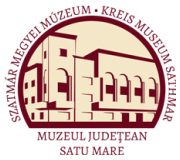Liviu, Marta - Szőcs Péter Levente (szerk.): Catalogul colecţtiei de archeologie (Satu Mare, 2007)
Istoricul colecţtiei de arheologie din Muzeul Judeţean Satu Mare
The history of the archaeological collection of the County Museum of Satu Mare The archaeological collection of the County Museum Satu Mare comprises several old collections. One of the t is the collection of antiquities of Kölcsey Association. ,s collection was founded in 1890, gathering antique ects and curiosities by the inhabitants of Satu Mare unty, passionate about history and art, in the second f of the 19th century. The objects were exhibited in three ms situated on the ground floor of the Calvinist College. : collection has greatly increased becoming extremely ied. According to the annual report of 1909, there were :ady 3910 archaeological objects: stone axes found in county, Roman construction materials from Aquincum idapest, at present), Greek vessels and Egyptian statues. : collection of the Catholic (Piarist) high school of Carei ; accomplished at the same time, comprising similar :es. This collection consisted of 667 pieces in the year ts foundation (1889), and already 4272 objects in 1921 [ 1922. A third nucleus of the present archaeological ection contains objects gathered by the Museum of x Mare County, founded in Carei, in 1901. The objects e exhibited in the headquarters of the county, and the íaeological objects resulted from the excavations carried when drawing up the monograph of Satu Mare County, this occasion, Aladár Vende has dug the Bronze Age lements of Potău-Cwncaş and Carei-Bobald. This ection was moved to Satu Mare subscribing to the founon of the Prefecture Museum. [he archaeological finds from the territory of Satu Mare mty have completed the patrimony of several museums he Central Europe during the 19th century. A golden :elet dating from the Bronze Age was found in Acâş, 855, and, at present, it is exhibited in the Museum of ana. The National Museum of Hungary houses bronze rds from Domăneşti (I), Stâna, Cămin, and the inventory Germanic grave from Apa. A bronze hoard from Lelei i the Museum of Cluj, and another bronze hoard found in Prilog is exhibited in the Museum of Nyíregyháza. Archaeological surveys were carried out by Márton Roska on the Paleolithic settlements from Bixad, in 1928, the finds being exhibited in the Transylvanian Museum of Cluj, too. The vestiges revealed by the first systematic archaeological excavations carried out in this region (the research on the earth castle of Boineşti-Cefafe), coordinated by József Mihalik, in 1892, were integrated in the collection of the high school of Vinogradov (Nagyszőllős). After the Second World War, with the reorganization of the territorial administration, the archaeological researches on the present territory of the county were coordinated by the Regional Museum of Maramureş, from Baia Mare. The older collections of the county of Satu Mare were gathered, deposited and exhibited in the City Museum of Satu Mare. This was situated in two rooms of the so-called “The House with electric clock”. Due to the lack of the specialists, in the first years after the war, the archaeological research was carried out by specialists from the main archaeological institutions of the country. The first excavation after the war, between 1953 and 1954, was carried out by the Museum of Sfântu Gheorghe in Pir-Cetate, and it was coordinated by Zoltán Székely. The Archaeological Institute of the Academy from Bucharest made archaeological excavations in the Paleolithic settlements from Bixad and Boineşti, coordinated by C. S. Nicolaescu Plopşor, in 1957. The Institute of Bucharest continued the research through Maria Bitiri in the sites of Boineşti, Remetea Oaşului, Călineşti-Oaş, Medieş Vii, Oraşul Nou and Turulung Vii. The same institution began additional excavations in several Neolithic settlements from Ciumeşti and Berea, led by Eugen Comşa and Alexandru Păunescu between 1961 and 1963. Vlad Zirra made the archaeological research of the Celtic settlements and cemeteries from Sanislău, Dindeşti and Ciumeşti, between 1962 and 1967. Beside the institute from Bucharest, the Archaeological Institute from Cluj participated in the archaeological researches of the county, too. The archaeologists: loan Glodariu, Hadrian Daicoviciu, Ioan-Horaţiu Crişan and Mircea Rusu made excavations in 13
